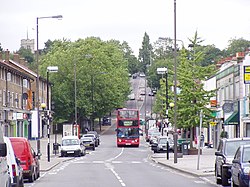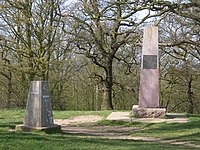Chingford
| Chingford | |
| Essex | |
|---|---|
 Chingford Mount | |
| Location | |
| Grid reference: | TQ395945 |
| Location: | 51°37’52"N, 0°-0’58"E |
| Data | |
| Post town: | LONDON |
| Postcode: | E4 |
| Dialling code: | 020 |
| Local Government | |
| Council: | Waltham Forest |
| Parliamentary constituency: |
Chingford and Woodford Green |
Chingford is a town in Essex, at the edge of the metropolitan conurbation.
Open country begins to assert itself at the northern and eastern edges of the town, while the west is bounded by the vast William Girling Reservoir and King George's reservoir, the two largest reservoirs in the valley of the River Lea dividing Essex from Middlesex to the west. To the south of Chingford Mount and South Chingford the conurbation runs contiguously towards Walthamstow.
The town has several of its own little suburbs; Chingford Green, Chingford Mount, Chingford Hatch and South Chingford, running in an arc from the east to the south.
To the north lies Epping Forest, which is in Essex but maintained by the City of London Corporation.[1]
Name
The River Ching runs through the area, and the town of Chingford is close to a number of crossings of that river. However, old maps and descriptions give a name for the settlement long before the river has a name and it is likely that the name of the river as "Ching" arose long after the settlement was named.
The leading theory is that the name has its origin as "Shingly Ford", which is to say a ford over a waterway containing shingles.[2] Another theory has it that Chingford is in origin the Old English Cyningesford ("Kings Ford").
Sights of the town
Queen Elizabeth's Hunting Lodge[3] stands here. Originally called the Great Standing, it was built for King Henry VIII in 1543, and was used as a grandstand to watch the hunting of deer, although it has been heavily altered over time. The building is located on Chingford Plain within Epping Forest and is open to the public.
Originally a barn built in the mid-19th century the Grade II listed building Butlers Retreat is one of the few remaining Victorian retreats within the forest. The building is adjacent to the Queen Elizabeth's Hunting Lodge and takes its name from the 1891 occupier John Butler. Retreats originally served non-alcoholic refreshments as part of the Temperance movement. After closing in 2009 the building was refurbished by the City of London Corporation and re-opened as a cafe in 2012.[4]
All Saints' Church in Chingford Mount (known locally as the Old Church) dates back to the 12th century. Directly opposite the church is Chingford Mount Cemetery, best known today as the burial place of the Kray family, of whjom the notorius Kray Brothers came.
Friday Hill House in Simmons Lane, off Friday Hill, dating from 1839, was a manor house built and owned by Robert Boothby Heathcote, who was both the lord of the manor and rector of the local church. It was he who paid for the building of the church of St Peter and St Paul in Chingford. He is buried in the Boothby family vault in All Saints' Churchyard (Chingford Old Church), Old Church Road. The vault was purchased by Robert Boothby (died 1733), who lived in the previous manor house. The present building has been used as a further education centre, but was put up for sale in 2012.[5][6]
Pimp Hall Dovecote is situated in a green area at the bottom of Friday Hill and can be viewed by entering the Pimps Hill Nature Reserve. The dovecote, which had nesting space for 250 birds, belonged to Pimp Hall (originally Pympe's Hall), one of three manor houses around Chingford. In 1838 the estate was taken over and became part of the Chingford Earls estate. The farmhouse associated with it survived until just before Second World War. There is a local legend telling how on one occasion Charles II was out hunting in Epping Forest and was caught in a snowstorm. He took shelter in Pimp Hall and was so delighted with the food offered him that he jocularly drew his sword and knighted the joint of beef declaring that it was now Sir Loin, though it is one of countless locations and one of several kings, which claims this almost certainly fictional story. Nevertheless, it is enough that the nearby pub on Friday Hill was named "The Sirloin".
A granite obelisk at Pole Hill was erected in 1824 under the direction of the Astronomer Royal, the Rev. John Pond M.A., to mark true north for the telescopes of the Royal Observatory at Greenwich, south of the Thames. It was placed on high ground along the line of the Greenwich Meridian, but when this was recalibrated later in the 19th century, the obelisk was deemed to have been erected 19 feet west of the revised meridian line. Today, an adjoining triangulation pillar marks the modern line.
Chingford Old Town Hall, dating from 1929, is on The Ridgeway in Chingford. It has more recently been known as the Chingford Municipal Offices. The site has been sold to property developers and the town hall building subsequently put up for sale itself.[7] [8]
Local sport teams
- Cricket: Chingford Cricket Club
- Football:
- Chingford Athletic Football Club
- Egbertian FC,Chingford's oldest football club, started by former pupils of the St Egberts College in 1928
- Rugby: Chingford Rugby Club, also founded in 1928
- Sailing; King George Sailing Club, founded in the 1970s, based on King George's Reservoir
Outside links
| ("Wikimedia Commons" has material about Chingford) |
- Churches:
- The Chingford War Memorial Project
- Sport:
- London's Railways
- Queen Elizabeth's Hunting Lodge
- Archival material relating to Chingford listed at the UK National Register of Archives
References
- ↑ "Epping Forest". cityoflondon.gov.uk. 2011-11-10. http://www.cityoflondon.gov.uk/Corporation/LGNL_Services/Environment_and_planning/Parks_and_open_spaces/Epping_Forest/. Retrieved 2012-01-16.
- ↑ "Chingford's Free Art and History". exploringeastlondon.co.uk. http://exploringeastlondon.co.uk/eel/Chingford/Chingford.htm. Retrieved 2012-01-16.
- ↑ "Queen Elizabeth's Hunting Lodge". Cityoflondon.gov.uk. 2010-12-16. http://www.cityoflondon.gov.uk/Corporation/LGNL_Services/Leisure_and_culture/Local_history_and_heritage/Buildings_outside_the_City/hunting_lodge.htm. Retrieved 2011-12-14.
- ↑ City of London- Butler's Retreat Retrieved 25 February 2013
- ↑ Waltham Forest Council: Friday Hill House Disposal
- ↑ Waltham Forest Council: Friday Hill House Sale Particulars
- ↑ Waltham Forest Council: Chingford Municipal Offices disposal
- ↑ Gilmartin Ley: The Old Town Hall, Chingford





